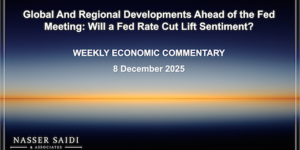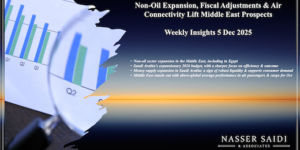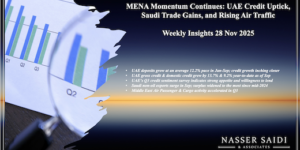GCC resilient despite geopolitical tensions & trade disruptions; Growing debt risks increases fragility Weekly Insights 11 Jul 2025
1. Middle East PMIs partially unperturbed by regional conflict
- Despite persistent geopolitical tensions and conflicts, GCC PMIs have remained in healthy expansion (50–55+) range. In contrast, respondents from Egypt and Lebanon have cited geopolitical concerns leading to declines in output, new orders and business sentiment.
- Comparing Q2 to Q1 2025, both UAE and Saudi Arabia have seen a modest decline in Q2 headline PMI readings while Qatar and Kuwait gained 0.1 and 1.3 points respectively. Egypt dipped to an average 48.9 in Q2 from the neutral-50.
- Comparing H1 2025 to H1 2024, Saudi gained the most (+1.3 points to an average 57.6); Egypt and Lebanon also gained (1.2 and 0.6 points) thanks to improved readings in Jan-Feb– partly due to the ceasefire deal and in the latter also given the formation of a new government.
- New order growth slowed in the UAE, with the Jun reading the lowest since Sep 2021 though output readings have remained strong and firms use ongoing work to sustain economic activity. Employment growth increased in Jun across Qatar (led by manufacturing), Saudi (expanding at the sharpest pace since May 2011) and Kuwait (record increase).
- Anecdotal evidence of increased wage pressures (Qatar, Saudi Arabia) led to higher input costs inflation while competitive pricing behaviour has resulted in decline in selling prices (Qatar); UAE however saw input cost inflation ease to a 2-year low and selling price dip. A further divergence in PMI expected: business sentiment weakened to a record low in Egypt while it climbed to a 2-year high in Saudi.

2. GCC headline inflation was relatively low vs MENA peers: highest in GCC was Kuwait (2.25% in May, lowest since Sep 2020) vs 14.4% in Lebanon (despite continued fixed rate and high dollarisation indicating major distortions) & 16.8% in Egypt (both for May). Food inflation dropped in 3 GCC nations: Bahrain’s sharp 9% decline + Oman and Qatar’s 0.8% and 0.6% fall). Dubai inflation rose to 2.37% in May (Apr: 2.31% & avg in 2025: 2.8%)

3. Saudi industrial production grew for eleven straight months in May, thanks to oil production activity (up in 7 of 11 months)
- Industrial production in Saudi Arabia grew by 2.5% mom and 1.5% yoy in May. Oil activities expanded by 0.5% mom and 2.0% yoy, as crude oil production rose to 9.184mn barrels per day (bpd), up from 8.99mn a year ago. Manufacture of coke & refined petroleum products surged by 2.1% yoy and 2.0% mom.
- Non-oil manufacturing activities increased by 2.5% mom and 4.8% in May. Within this segment, the manufacture of chemicals & chemical products was the fastest growing (14.0% yoy) followed by non-metallic products (10.5%).
- Forward-looking non-oil private sector PMI implies further momentum in the coming months. PMI has been robust in 2025, clocking in an average 57.6 in H1 (vs 56.3 in H1 2024), supported by strong domestic demand and new orders. Industrial demand also comes from giga-projects’ progress (e.g. via construction materials) and from government initiatives such as Made in Saudi and industrial city developments (e.g. Jubail Industrial City, OXAGON, King Salman Energy Park – SPARK). Investments in smart manufacturing, automation, data centres and the like will also increase efficiency and productivity.

4. Middle East international tourist arrivals rise 44% in Q1 2025 vs 2019
- UNWTO reported that an estimated 300mn tourists travelled internationally in Q1 2025 (+5% yoy), growing despite ongoing geopolitical tensions. Tourist arrivals are expected to grow between 3% to 5% this year, though the Panel of Tourism Experts survey highlights high travel costs and the recent increase in tariffs as the main challenges.
- Middle East posted the strongest recovery compared to pre-pandemic levels , up 44% (but clocking in a modest 1% from a year ago). In yoy terms, Egypt (21%), Jordan and Bahrain (both 9%) saw the highest growth in arrivals in the Middle East.
- Africa and Europe grew by 16% and 5% in Q1 (vs 2019) while Asia-Pacific grew by 13% yoy, it was still 8% below pre-pandemic levels.
- Among the best performing destinations in Q1 2025 in terms of international tourist arrivals were Qatar (top, +158% vs 2019), Saudi Arabia (3rd, +102%), Morocco (9th, +60%) and Bahrain & Egypt (15 & 16th, +40%). Visa and travel facilitation measures are expected to benefit the GCC nations (e.g., the recently announced unified GCC tourist visa policy)
- International tourism receipts had a strong Q1, following the upward revision of 2024 numbers to USD 1.7bn (thanks to high average spending per trip). Saudi Arabia topped the list of best-performing destinations in terms of receipts (+252% in Q1 2025 compared to 2019) while Tunisia and Morocco posted gains of 62% and 49% respectively.

5. 2024 debt-to-GDP levels in more than half the MENA countries higher than pre-pandemic levels
- Public debt in the Arab region surged to USD 1.7trn+ in 2024, over half of the region’s GDP.
- Middle income countries – Algeria, Egypt, Jordan, Lebanon, Morocco & Tunisia – hold close to half the public debt (2024: USD 720bn+). Bahrain has one of the highest public debt as share of GDP (123% in 2024); it is 90%+ in Jordan & Egypt
- According to UNCTAD, public debt & interest payments in the Arab region was above USD 31bn in 2024 – amounting to an average of 9.9% of revenues, posing additional liquidity & fiscal challenges.
- Costly interest payments (from debt) can crowd out government spending on health, infrastructure, education etc. UNCTAD finds that 3.4bn persons live in countries that spend more on interest payments than on either health or education.

Powered by:









